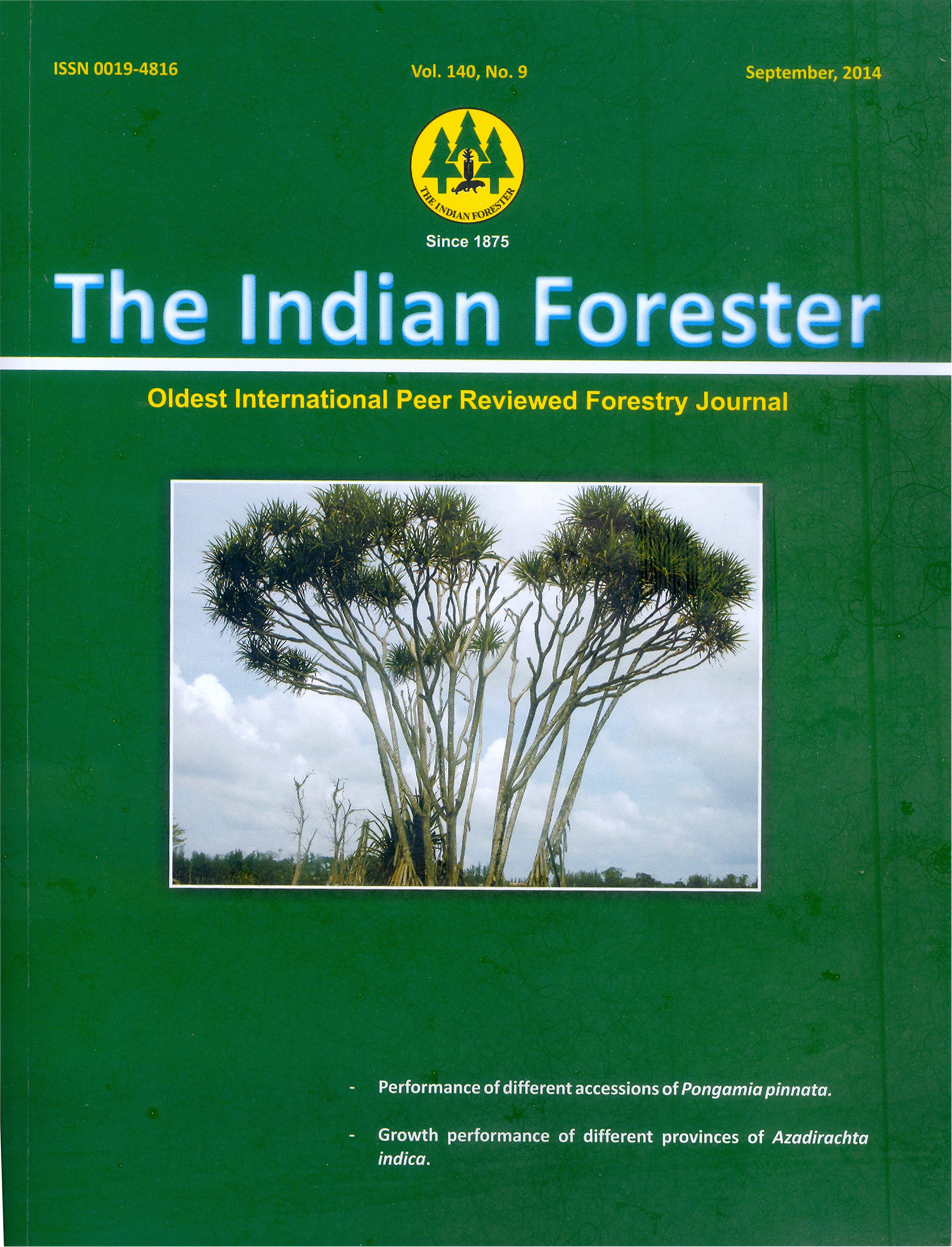Performance of Different Accessions of Pongamia Pinnata
DOI:
https://doi.org/10.36808/if/2014/v140i9/52347Keywords:
Pongamia Pinnata , Performance, Accessions, CuttingsAbstract
Pongamia pinnata is one of the most promising tree borne oil seed species. Ten better performing accessions mainly based on fruiting were evaluated. Uniform size semi-hardwood cuttings were made and were treated with IBA @ 600 ppm. The cuttings were measured, after 75 days of planting for root length, shoot length, collar diameter, fresh weight and dry weight. The shoot length, collar diameter, fresh weight and dry weight had shown significant difference between the sources. Broad sense heritability was highest for rooting (99.58%) followed by fresh and dry weight. Fresh weight showed high genetic advance. The sources Mundara (Tikamgarh) and Khadauli (Agra) performed better in terms of dry matter production as well as rooting.References
AhujaS.,MalhotraP.K.,BhatiaV.K.andPrasad R.(2008).Statisticalpackageforagricultural research (SPAR2). J. Ind.Soc.Agri.Statist.,62:65-74.
Allard R.W. (1999). Principles of Plant Breeding (2nd edt). New York: John Wiley & Sons, p. 254.
Burton G.W. (1952). Quantitative inheritance in grasses. Proc. 6th Intl. Grassland Cong., 1: 227–283. (6th ed.) Iowa, USA: Iowa State Univ. Press, p.267.
Campbell R.K. and Sorensen F.C. (1978). Effect of test environment on expression of clines and on delimitation of seed zones in Douoglas-fir. Thor. Appl. Genet., 51: 233-246.
Chopade V.V., Tankar A.N., Pande V.V., Tekade A.R., Gowekar N.M., Bhandari S.R. and Khandake S.N. (2008). Pongamia pinnata: Phytochemical constituents, traditional uses and pharmacological properties: A review. Int J Green Pharm [serialonline] 2008 [cited 2011Dec30];2:72from: http://www.greenpharmacy.info/text.asp?2008/2/2/72/41173
Elanchezhiyan M., Rajarajan S., Rajendran P., Subramanian S. and Thyagarajan S.P. (1993). Antiviral properties of the seed extract of an Indian medicinal plant, Pongamia pinnata, Linn., against herpes simplex viruses: in-vitro studies on Vero cells. J. Med. Microbiol, 38(4): 262-4.
GOI (Government of India) (1983). Troup's The Silviculture Of Indian Trees, Volume IV, Leguminosae. Government of India Press, Nasik, India. 345 p.
Goulden C.H. (1952). Some distance properties of latent root and vector methods used in multivariate analysis. Biometrica, 53: 325- 338.
Johanson H.W., Robinson H.F. and Comstock R.E. (1955). Estimate of Genetic and environmental variability in soyabeans. Agron J., 47: 314- 318.
Karoshi V.R. and Hegde G.V. (2002). Vegetative propagation of Pongamia pinnata (L) Pierre: hitherto a neglected species. Indian Forester, 128 : 348–350.
Kesari V., Krishnamachari A. and Rangan L. (2009). Effect of auxins on adventitious rooting from stem cuttings of candidate plus tree Pongamia pinnata (L.), a potential biodiesel plant. Trees: Structure and Function, 23 (3) : 597–604.
Mishra P.K., Mohanty J.R., Acharjyo L.N., Thatoi H. and Ouseph A. (2001). Vegetative propagation by stem cuttings with auxins of four mangrove (and associate) species of Bhitarkanika, India. J. Trop. For. Sci., 13 (1) : 223–227.
Mukta N. And Sreevalli Y. (2010). Propagation techniques, evaluation and improvement of the biodiesel plant, Pongamia pinnata (L.) Pierre—A review. Industrial Crops and Products,31 (2010) 1–12. www.elsevier.com/locate/indcrop
Negi K.S. and Tiwari C.K., (1984). Vegetative propagation in cuttings of Pongamia pinnata Pierre by auxins. Indian Forester,110 (7) : 655–659.
Palanisamy K. and Kumar P. (1997). Seasonal variation on adventitious rooting in branch cuttings of Pongamia pinnata Pierre. Indian Forester,123 : 236–239.
Palanisamy K., Ansari S.A., Kumar P. and Gupta B.N. (1998). Adventitious rooting in shoot cuttings of Azadirachta indica and Pongamia pinnata. New Forester, 16: 81–88.
Punitha R. and Manoharan S. (2006). Antihyperglycemic and antilipidperoxidative effects of Pongamia pinnata (linn.) Pierre flowers in alloxan induced diabetic. J. Ethon Pharmacol, 105: 39-46.
Rameshthangam P. and Ramasamy P. (2007). Antiviral activity of bis (2-methylheptyl) phthalate isolated from Pongamia pinnata leaves against White Spot Syndrome Virus of Penaeus monodonFabricius. Virus Res., 126(1-2): 38-44. Sahoo D.P., Aparajita S. and Rout G.R. (2010). Inter and intra-population variability of Pongamia pinnata: a bioenergy legume tree. Plant Syst Evol., 285:121–125.
Sangwan S., Rao D.V. and Sharma R.A. (2010). A Review on Pongamia Pinnata (L.) Pierre: A Great Versatile Leguminous Plant. Nature and Science, 8(11).
Scott P.T., Pregelj L., Chen N., Hadler N.S., Djordjevic M.A. and Gresshoff P.M. (2008). Pongamia pinnata: An Untapped Resource for the Biofuels. Industry of the Future, Published online. Bioenerg.Res.,1:2–11.
USDA. (2011). ARS, National Genetic Resources Program. Germplasm Resources Information Network - (GRIN) [Online Database].National Germplasm Resources Laboratory, Beltsville, Maryland.URL: http://www.ars-grin.gov/cgi-bin/npgs/html/taxon.pl?418408.
Downloads
Downloads
Published
How to Cite
Issue
Section
License
Unless otherwise stated, copyright or similar rights in all materials presented on the site, including graphical images, are owned by Indian Forester.





